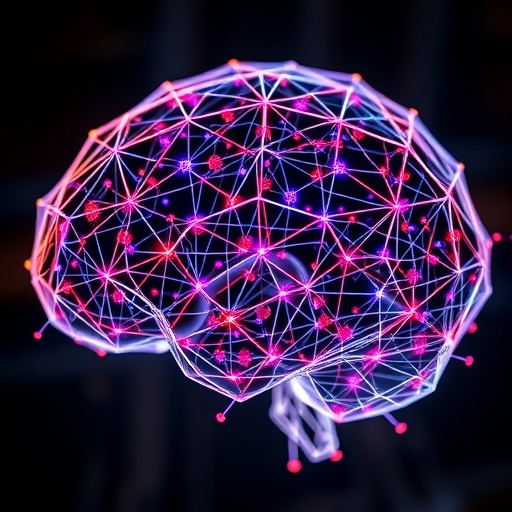In a groundbreaking advancement poised to revolutionize computational neuroscience, researchers have unveiled JAXLEY, a cutting-edge open-source software toolbox designed to simulate brain activity with unprecedented realism and efficiency. This innovative framework seamlessly integrates the biophysical fidelity of detailed neuron models with the computational prowess of contemporary machine learning methodologies. Featured in the latest edition of Nature Methods, JAXLEY promises to reshape how scientists investigate the electrical dynamics of neurons and neural networks, offering a window into cognition, perception, and memory once obscured by computational complexity.
Understanding how individual neurons and complex networks give rise to higher-order brain functions has long challenged neuroscientists. Traditional biophysical models, which strive to replicate neurons’ electrical signaling based on physics and biology, rely on vast systems of nonlinear differential equations. Though these models accommodate the intricate properties of ion channels, membrane potentials, and synaptic interactions, their parameter spaces are enormous and finely detailed. Accurately tuning these parameters to mirror experimental data has historically demanded exhaustive manual adjustments or prohibitively time-consuming trial-and-error simulations, often stretching across weeks of computational effort.
JAXLEY addresses these limitations head-on by borrowing insights from modern machine learning, particularly differentiable programming. Differentiable simulation refers to the ability to compute gradients—or sensitivities—of model outputs with respect to input parameters. This capability enables the model to automatically determine how subtle changes influence neuronal behavior, facilitating gradient-based optimization. Consequently, biophysical neuron models can be trained directly on large experimental datasets, bypassing slow heuristic tuning. The toolbox exploits the parallel processing power of graphical processing units (GPUs), traditionally used in artificial intelligence training, accelerating simulations and parameter adjustments dramatically.
At the core of JAXLEY lies an ingenious fusion between neuroscience’s biophysical rigor and machine learning’s scalability. This synergy empowers researchers to scale simulations to thousands or even hundreds of thousands of parameters, capturing vast neural network complexity without sacrificing accuracy. Unlike classical methods, which often falter under computational weight as network size expands, JAXLEY thrives on parallel computations, enabling an unprecedented breadth of neural architecture to be explored within reasonable timeframes. Its open-source nature ensures broad accessibility, inviting continual refinement and usage by the global neuroscience community.
The architecture of JAXLEY extends beyond mere acceleration. By enabling differentiable inference, the toolbox allows neuroscientists to perform in silico experiments where the model learns to reproduce empirical neuronal firing patterns and network dynamics directly from experimental data or predefined computational tasks. Such an approach marks a paradigm shift: rather than relying solely on biological intuition or rough approximations, researchers can now harness data-driven optimization to uncover parameters and mechanisms underlying observed neural phenomena objectively and reproducibly.
In demonstrating JAXLEY’s versatility, the research team rigorously tested it on a diverse suite of challenges. The toolbox flawlessly reconstructed detailed electrical activity from individual neurons, replicating their response to stimuli with fine temporal and spatial precision. On a grander scale, it effectively trained extensive biophysical networks to execute complex memory and visual processing tasks, navigating parameter landscapes encompassing up to 100,000 variables. These results attest not only to JAXLEY’s computational horsepower but also to its practical applicability in modeling cognitive functions with unprecedented fidelity.
Beyond technical feats, JAXLEY signifies a conceptual leap in linking brain-inspired computation and machine learning. The toolbox’s adaptive, data-centric learning paradigm echoes biological learning principles, potentially unraveling how neural circuits self-organize and adapt during development and experience. By replacing tedious manual parameter adjustments with automated, gradient-based learning algorithms, neuroscientists are equipped to probe emergent neural computations grounded directly in biophysics rather than abstractions.
Pedro Gonçalves, the group leader spearheading the project at Neuro-Electronics Research Flanders (NERF) and VIB.AI, emphasized the transformative potential of JAXLEY. He articulated, “JAXLEY fundamentally changes how we approach brain modeling. It enables us to build realistic models that can be optimized and scaled efficiently, opening new ways to understand how neural computations emerge from the brain’s underlying processes.” This statement encapsulates the cross-disciplinary breakthrough — bridging computational efficiency, biophysical realism, and machine learning sophistication.
The toolbox’s development stems from collaborative efforts involving NERF, imec, KU Leuven, VIB, and the University of Tübingen, highlighting a broad alliance at the interface of neuroscience and AI research. Supported by prominent funding bodies such as the German Research Foundation, the German Federal Ministry of Education and Research, Carl Zeiss Foundation, and the European Research Council, the initiative underscores the scientific community’s commitment to cultivating next-generation neuroinformatics tools.
Looking forward, JAXLEY offers a fertile platform for expanding the frontiers of computational neuroscience. By enabling direct training of biophysically detailed neuronal networks on experimental or task-driven data, it opens the door to exploring brain phenomena previously elusive due to computational bottlenecks. Researchers may leverage this platform to simulate disease models, analyze synaptic plasticity, or even develop brain-machine interfaces grounded firmly in physics-based neuron models but accelerated by AI techniques.
Furthermore, the open-source availability of JAXLEY invites researchers worldwide to contribute code enhancements, tailor the framework to diverse neuron types and network configurations, and connect it with other computational tools. This collaborative spirit will likely fuel rapid innovations, democratizing access to high-fidelity brain simulations and sparking discoveries that bridge biology and computation.
In summary, JAXLEY represents a milestone in neurocomputational methodology, demonstrating how differentiable simulation combined with GPU acceleration can drastically improve the speed, scale, and realism of biophysical neuron models. As neuroscience increasingly embraces machine learning paradigms not just as analytical tools but as integral components of model construction and optimization, frameworks like JAXLEY will be essential in unraveling the neural code. Its impact promises to resonate across fields, from computational biology to AI, offering a profound new lens through which to understand the brain’s astounding complexity.
Subject of Research: Not applicable
Article Title: JAXLEY: Differentiable simulation and inference for biophysical neuron models
News Publication Date: 13-Nov-2025
Keywords: Computational biology, Biophysics, Cell biology, Neuroscience, Signal transduction
Tags: biophysical neuron modelingbrain-inspired modelscognitive neuroscience breakthroughscomputational neuroscience advancementsdifferentiable programming techniquesenhancing experimental data accuracyJAXLEY software toolboxmachine learning in neuroscienceneural networks researchneuronal electrical dynamicsrevolutionizing brain function studiessimulating brain activity





